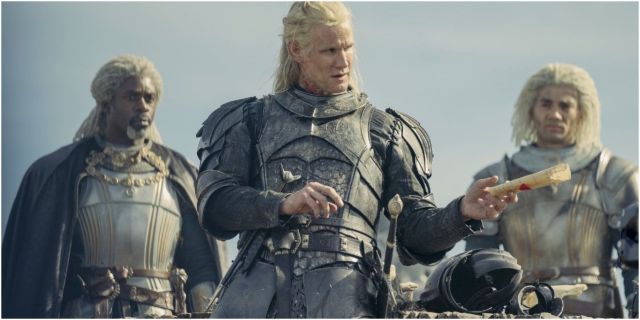Political issues dominate huge portions of Game of Thrones. Though the series sells itself on sex and violence, it packs more foreign policy, wartime logistics, and trade negotiations than the average prestige epic. House of the Dragon delivers the same mix, with the grim battle between family members fought in political and physical terms. One of the earliest elements of the series is the Triarchy, a collective government that was mysteriously absent from Game of Thrones.
House of the Dragon took a strange approach to its timeline in its first season. Several years often pass in the week-long gap between weekly episodes. Binge-watching the series now is unusual, as its ten hours consume more than 15 years. Game of Thrones often spent several episodes exploring the events of a few days. A side effect of House of the Dragon‘s timeline is that minor elements, like the Triarchy, seem to come and go overnight.
RELATED: House Of The Dragon: The Greatest Kingsguards, Ranked
What is the Triarchy?

The Triarchy is a combined government overseeing three of the nine Free Cities. It formed in 96 AC after their naval forces cleared the Disputed Lands. The once all-consuming Valyrian Freehold forged the Free Cities as colonies, granting each some autonomy while using them as trading outposts. Valyria suffered a sudden and nigh-apocalyptic cataclysm called the Doom, which ended its several thousand-year reign in moments. With Valyria in ruins, the Free Cities became wholly independent. Volantis, the oldest and proudest Free City, quickly struck to secure domination over its siblings. Three smaller cities, Lys, Myr, and Tyrosh, opposed Volantis. They joined forces to form the Triarchy. The people of Westeros called their union the Kingdom of the Three Daughters. The three groups called it an “eternal alliance.” The Triarchy was ruled by a council of 33 wealthy magisters, eleven from each city. Each part of the Triarchy added something to the arrangement.
Lys
Lys is celebrated worldwide for its beauty. Its climate is tropical, with plenty of sunshine. Its flora is plentiful with delicious fruits. The water surrounding the island is clear, glorious, and full of fish. Even the people of Lys are renowned for their appearances. Lys values mercantile skill and wealth above any other virtue. There is no formal town guard, as sellswords defend the city’s high walls. Family title counts for less in Lys than elsewhere, meaning anyone with enough coin can rise to the upper echelon of society. Lys also has a strong tradition of sex work, much of which is furnished by kidnapping women and children from passing vessels. During the Triarchy, Lys earned Westeros’s ire by taking ladies hostage to serve in brothels. Admiral Sharako Lohar led Lysene naval forces, but a courtesan, Johanna Swann, became the city’s unofficial leader.
Myr
Considered the most advanced of the Free Cities, Myr’s most notable export is their crafts. People pay exorbitant prices for Myrish goods, from carpets to paintings. Myrish craftspeople developed lenses that remain unmatched by any other sort, making them the go-to source for telescopes and spyglasses. Myr produced the most notable army leader of the Triarchy, Prince Admiral Craghas “Crabfeeder” Drahar. Drahar led the invasion of the Stepstones that briefly cleared the narrow passage of pirates. He collected tolls that gradually rose, eventually including slaves. His reign, like all powers over the Stepstones, was brief.
Tyrosh
This well-guarded city has the largest fleet among the Triarchy. Tyrosh holds skilled inventors who create the finest torture devices in the Known World. It’s a dedicated meeting place where many critical negotiations were held. Tyrosh’s contribution is more straightforward, dedicating countless ships and sellswords to the Triarchy. Tragically, few of their ships returned to the walled city.
What happens to the Triarchy?

Fans see the Triarchy through King’s Landing’s perspective. King Viserys I Targaryen’s Small Council alerts him to the Triarchy’s assault on the Stepstones. The Triarchy clears the pirates, though they always come back, and levies tolls. Crabfeeder’s actions draw attention from Corlys Velaryon, the Sea Snake. Prince Daemon Targaryen, Viserys’ brother, seeks to destroy the Triarchy to claim the Stepstones as his own. He claimed much of the island chain, leading the Triarchy to back his nephew, Aegon II. The Triarchy fought in the bloodiest sea battle in history, the Battle of the Gullet. Despite slaying a valuable enemy leader, they failed to break Velaryon’s blockade. The Triarchy suffered such severe losses that they abandoned the Dance of the Dragons. The Triarchy later fell apart due to in-fighting. Lysene leader Sharako Lohar died in a fight over Johanna Swann’s hand. Tyrosh mistakenly believed Myrish assassins were responsible, leading to several violent reprisals. The Triarchy fell apart, splitting the Disputed Lands among them.
The Triarchy was a fascinating, short-lived collection of ambitious leaders. The Free Cities remained prosperous long after the dissolution of their supposed “eternal alliance.” The Triarchy was a decent idea marred by consistently terrible execution and the excesses of all involved. Though they claimed power for a moment, the Three Daughters just couldn’t get along.











Leave a Reply